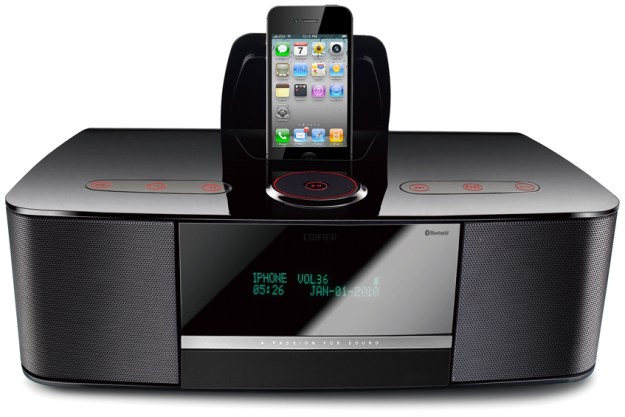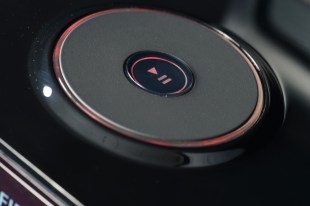
“The Esiena is well-designed, easy to use and sports an impressive array of features, but its audio quality left us wanting for more.”
- Rich feature set
- Slick style
- Intuitive navigation
- Lean on bass
- Treble lacks clarity
- Veiled midrange
- FM presets are quirky
Founded in China in 1996, Edifier is a relatively new name here in the states, but has been garnering praise for its innovative engineering and design. It produces millions of units a year and has grown into a multinational corporation, with one of its main research facilities located in Vancouver, BC. We’ve checked out some of Edifier’s products in the past, including the E3350 and the Luna 5 Encore iF500, and we were pleasantly surprised by the company’s ability to squeeze a lot of sound quality into a smart little package.
In October, we previewed Edifier’s latest iPhone dock release, the Bluetooth-compatible Esiena iF360 BT. With a price tag of around $300, the Esiena is more than just a plug-and-play dock. It is chock full of features, beautifully designed, and promises premium quality sound. However, in a field brimming with new Bluetooth devices and speaker sets, the competition is fierce, and we were eager to see how well this sleek little unit would stand up to the tide. Here’s what we discovered.
Out of the box
Pulling away the cardboard flaps of the Esiena’s package, we found a small white box and a white corded bag sandwiched between two pillars of foam. The box contained a 3.5 mm to RCA adapter cable, an FM antenna cable, a small remote with a pre-loaded lithium battery, a baggy full of plastic iPod adapters of various sizes, and a power cable. Separating the two foam pieces, we pulled out the white bag containing the Esiena and removed the clean black dock from within, revealing what looks a bit like an oversized clock radio from the future.

Features and design
The Esiena is cased in shiny black plastic, with a black matte finish on the front and sides. Its curved, V-shaped design and glossed sound ports give the unit some flash, like the fender of a muscle car. On the top is a selection of glowing red control buttons flanking a circular track pad which handles play/pause, volume and navigation, and gives the design a strikingly Apple-esque vibe. Also on top is a small flap which pops up to reveal the 30-pin iPod connector beneath. On the front is a large black digital menu window, a small silver accent bar, and two small rectangular screens that encase the Esiena’s 3-inch drivers.
As we said, the Esiena is loaded with features and available inputs. Along with its iPod input and Bluetooth connectivity, the Esiena boasts an SD card input, a USB input, an auxiliary RCA input, and an FM radio with 27 selectable channel presets. There are also five available alarms which can be set with each connected input, except Bluetooth (which was slightly disappointing, as we had hoped to set an alarm to our iPhone from across the room). The alarm function works well, rising gradually in volume to your chosen preset volume level, and snoozing at the press of any button.
We found most of the Esiena’s features simple and intuitive with the exception of the FM radio presets. If you don’t set the presets manually (which takes forever) you’re stuck with the first 27 stations the Esiena finds, and it’s hard to go in and add/remove stations individually without getting lost in a digital maze. Also, you have to use the presets for the FM alarm instead of the station number. So, if you don’t remember your preset numbers, you run the risk of waking up to something terrible. Still, the array of features is impressive, and the FM tuner is powerful enough that it picked up far more stations than our rather average clock radio.
A docked iPhone was easy to navigate with either the remote, or with the onboard trackpad. With Bluetooth connected, there were no clicking sounds or loud beeps – annoying quirks that we’ve endured with some of the other docks we’ve tested – and pairing was a snap. Our only real issue with Bluetooth audio was a slight loss in sound quality. While the iPhone was in the dock, music sounded warmer, more resonant, and had more clarity in the treble region than with Bluetooth. While the difference isn’t striking, super picky listeners may not be pleased. We still love the functionality of Bluetooth, and we think it won’t be much of an issue for most listeners.
Audio performance
Given our past experience with Edifier, and the Esiena’s $300 price tag, we had pretty high expectations for this stylish little speaker dock’s sound quality. Unfortunately, we discovered early on in our evaluation that it has some real limitations. With only a pair of 3-inch drivers at work, we weren’t holding our breath for thunderous bass or radiant treble, but we had hoped for a wider spectrum of sound than was delivered.
We started by pulling out a few of our favorite hip-hop tracks, and gave the Esiena a good bit of juice. We were disappointed to find that much of the low groove either missing or only partially there. As the beat hit, we noted a sort of boxed-in kick drum, like it had been miniaturized. Adjusting the bass up and down on the remote seemed only to slight effect the midrange response, muddying it clearing it up, without any real low-end correction.

With other genres, the Esiena fared much better. When we tested one of our all-time favorite albums, Sgt. Pepper’s Lonely Hearts Club Band, the Esiena reproduced the tracks with a full, warm presence. As we listened to songs like “Being for the Benefit of Mr Kite,” and “Good Morning,” the horns sounded a little thin and scratchy, but Ringo’s toms were pleasantly thick, bouncing through the presentation with a low, midrange punch. Crash cymbals had a soft, organic sustain, and we felt George Martin’s signature production style was well showcased. However, we also noticed some clarity issues in the upper registers – things tended to get a bit foggy in the treble.
As we listened on through several more styles of music, we often found ourselves wishing for more definition in the instrumentation. There was a persistent muffled effect that left us wanting for deeper detail, as if there was a barrier between us and the speakers. We couldn’t help thinking that the Esiena was overly focused on the midrange — there were no particularly stunning moments in the treble, and there was no real bass to speak of. In short, the Esiena sounded like a lot of iPod docks we’ve heard: balanced with few errant tones, but with no real power or brilliance. That’s not to say the sound was bad, but for the price, we had hoped for a little more wow factor.
Conclusion
The Edifier Esiena is conveniently sized, looks cool, and is relatively easy to use. The Bluetooth function is simple and hassle-free, and the on-board controls and remote made navigating the various inputs convenient and easy. That being said, we were underwhelmed with the audio performance. Given our past experience with Edifier, we had expected to be wowed by the sound, and that just didn’t happen. We feel that some of the features on the Esiena are a little unnecessary, and we would have gladly traded a few of them in for higher audio quality. Still, if you have a less critical ear and you’re in the market for a sharp device loaded with features, the Esiena is worth giving a listen.
Highs
- Rich feature set
- Slick style
- Intuitive navigation
Lows
- Lean on bass
- Treble lacks clarity
- Veiled midrange
- FM presets are quirky






